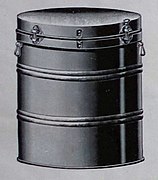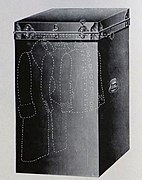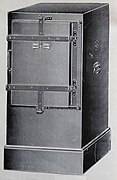Fur capsule
In the first half of the 20th century, metal containers were advertised as fur capsules , fur safes and , if they were appropriately designed, also fur closets , which were used in particular to store fur clothing. The lockable containers protected the contents from insect infestation, dust, fading from exposure to light and made it difficult to steal the possibly valuable contents.
General
At the end of the 19th century, fur was no longer worn with the hair on the outside. The fur sewing machine had just been invented and fur became affordable to a much wider segment of the citizenry. With the rise in fur ownership, it seemed worthwhile for some manufacturers to offer this supposedly excellent storage facility for the long-lasting product when handled properly.
As a rule, the fur capsules were designed in such a way that several items of clothing could be stored in them while hanging on hangers. The Dresden fur clothing company Stöckig & Co. also offered cardboard-shaped metal containers in its brochure, in which smaller furs, woolen items or uniform parts could be stored lying flat.
An example from the Netherlands shows how important proper storage can be. Queen Juliana , known as frugal, did not give her royal cloak to the furrier in the fur preservation in 1948 after the one-time use at the inauguration . She didn’t keep it in a tin box, but in a metal, small lead box. When it was removed in 1980 because of the upcoming enthronement of daughter Beatrix , it was found that the fur was "incredibly wrinkled" and the red velvet had rubbed off on the ermine and the silk lining. The entire velvet of the cape was therefore replaced. The ermine fur of the coat, lining and trimming should not be renewed. The parts of the hood that were still usable were used to repair the fur lining, but were not enough. The hair, which was once snow-white, was now so yellowed that it could not be repaired or supplemented with new pelts. Beatrix's seamstress therefore asked her customers whether they still had ermine clothing there. Three customers answered. The ermine cape was used by Elly Brenninkmeyer-Maurer, the wife of the head of C&A Brenninkmeyer . The Brenninkmeyers never revealed the story to the outside world, only in their family circle it was always called "a royal coat with fur from C&A".
So that the furs are not infested with pests such as clothes moths or fur beetles before they are stored, they are carefully knocked out beforehand in order to destroy any insect larvae. Often the tapping is repeated a few weeks later to be on the safe side. A clump-like hair loss is a sign of moth infestation.
Today, storage in the airtight containers is no longer considered best practice. Since the 1950s at the latest, specialist retailers have been recommending keeping furs dark, cool and protected from moths, but in air-permeable covers, if they are not given to the furrier during the summer. Even if furs, in contrast to earlier times, have no or hardly any wild odor or other inherent odor, it is common today not to keep them airtight for months. In addition to the natural smell of its own, substances were usually added to the furs that were known or assumed to kill insects or to deter moths by their smell. Naphthalene was effective as moth powder or mothballs, which, however, also has a strong odor and is now considered harmful to health and the environment. Paul Heussi from Leipzig had completely lined the capsule offered by him, in 1909 still as "moth capsule", with camphor wood, which was assumed to be anti-moths . He stated in his advertisement that "Camphor wood never loses its smell". The fur bearer could often be recognized from a distance by the typical scent.
Old fur capsules or fur cabinets are offered again and again on the Internet. As a remnant of a former small, so-called fur museum, two fur capsules are still standing in the courtyard of the furrier and fur dressing shop Udo Meinelt & Sons in Rötha near Leipzig and can be viewed there.
From around 1910, a one and a half meter wide and 88 centimeter high fur safe in a special, rounded chest shape was offered on an online marketplace from Mainz in 2010. The look was that of a high-quality piece of bourgeois furniture of the time. The "heavy" chest and the removable lid were made of two-tone brown stained, lacquered oak, the long side with an inlay decoration. The inside was lined with sheet iron painted yellow. The metal container with two lid flaps that closed against each other was secured with an integrated lock.
In the book about the American presidential family, "My Name is Trump - Behind the Scenes of America's First Family", a fur closet in their penthouse owned by Donald Trump's wife Ivana is mentioned, which is temperature and humidity controlled. The wife of the German ship designer Gösta Schwiers is said to have had such an air-conditioned device in her yacht cabin in 2000.
Offers from the purveyors to the royal Lippe court, Stöckig and Co., Dresden and Bodenbach in 1912
In a 70-page catalog, from around 1912, the company Stöckig & Co. offered a selection of different metal containers for storing fur and other items of clothing to be protected in addition to their fur clothing. At that time, the company was already operating a mail order business for furs and sent them for inspection upon request. Many of the customers on site may not have had the opportunity to give the fur they had purchased from Stöckig to a furrier to store them in the summer , and it may also be uncomfortable to go there with a piece they had just bought elsewhere. In addition, it made no sense for the company to send its customers to the competition for service. This is certainly where the idea of offering buyers a storage alternative at the same time as buying them comes from.
The catalog explains that hair and leather can be kept their natural freshness and suppleness by keeping them cool in well-sealed fur capsules made of sheet iron. Regular tapping is recommended as the best remedy for moths.
The sheet iron fur capsules offered were painted spongy-like on the outside and painted blue on the inside. They had high edges, the lids could be removed and screwed on with four socket wrench screws each. Inlaid rubber strips enclosed the contents practically airtight. Between every two screws there was an iron bracket to attach two padlocks. Left and right there was a foldable black handle. The higher capsules had a removable iron crosspiece, "for hanging up furs and such items of clothing which, because of their shape, should be particularly spared and should therefore be hung on hangers".
The low versions were offered as "suitable for storing mugs , boas, collars, hats or other small items of clothing". For the most complex, front-loading model, you could also get a wooden base painted brown.
- Fur capsules, floors and Co.
Fur boxes, garment sleeves
Long before the appearance of the fur capsules, it was possible to store smaller pieces of fur in closed containers. The furriers often gave their customers a box for fur ties when they bought them, but especially when they bought a hat box or a muffin box . At least since the second half of the 20th century, when buying a fur jacket or a fur coat in many specialty shops, customers have received a suitably long garment sleeve that can be closed with a zipper. Ideally, it consists of nettle or some other material that is well permeable to air. Airtight plastic sleeves are unsuitable for long-term storage of furs.
See also
Web links
literature
- The care of the fur jewelry. Eschebach fur capsule . United Eschebach'sche Werke AG., Dresden and Radebeul, around 1935 (4 pages)
Individual evidence
- ↑ Dieuwke Grijpma, Dorine Hermans: Kringloopmantel. In: de Volkskraat. Amsterdam, March 18, 2013, p. 2, V3-V4 (Dutch).
- ↑ Dieuwke Grijpma: The unpaid royal mantle from Basel. In: bz, focus Basel. Northwestern Switzerland, April 29, 2013, p. 18.
- ^ Advertisement by Heussi's Mottenkapsel , 1909.
- ↑ The two fur capsules in Rötha .
- ↑ Fur chest chest safe around 1910 inlaid oak. Rarity! . Ebay offer no. 160514535747, provider kleinanna999, end of offer December 13, 2010 20:25:57 CET, location Mainz. Dimensions: 0.88 m high, 1.53 m wide, 0.67 m deep (the offer and the seller are no longer accessible).
- ↑ Emily Jane Fox: My Name is Trump - Behind the Scenes of America's First Family . HarperCollins, 2018. E-Book ISBN 978-3-95967-822-3 . Last accessed on November 16, 2019.
- ↑ Elisabeth Stimming: The Lord of the Ships disembark . Hamburger Abendblatt, December 16, 2000. Last accessed on November 16, 2019.
- ↑ Stöckig & Co., Dresden, Pelzmode-Katalog 1912 , pp. 5, 70.







